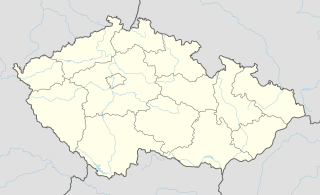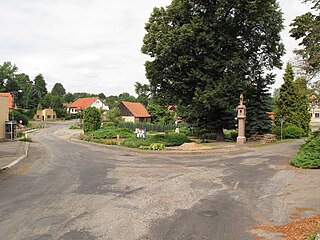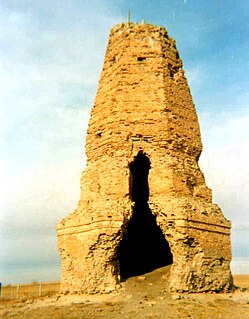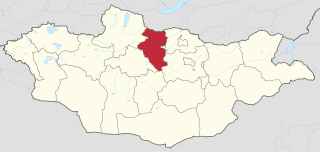
The Xiongnu were a tribal confederation of nomadic peoples who, according to ancient Chinese sources, inhabited the eastern Eurasian Steppe from the 3rd century BC to the late 1st century AD. Chinese sources report that Modu Chanyu, the supreme leader after 209 BC, founded the Xiongnu Empire.

Bulgan is a town, administrative centre of Bulgan province of Mongolia. Bulgan sum has a population of 11,984, 12,323 (2008), town proper has a population of 11,198 (2008). It is located at the site of the former Daichin Wangiin Khüree monastery at an elevation of 1,208 metres (3,963 ft) and 468 kilometres (291 mi) from Ulaanbaatar.

This is a list of the extreme points of the Czech Republic: the points that are farther north, south, east or west than any other location.
Khishig-Öndör is a sum (district) of Bulgan Province in northern Mongolia.
Orkhon is a sum (district) of Bulgan Province in northern Mongolia. The former Soviet Army military base area is 6 km southwest of the sum center.
Bayangol is a sum (district) of Övörkhangai Province in southern Mongolia.

Prusice is a village in the Central Bohemian Region of the Czech Republic. On the date October 2, 2006 it has 55 inhabitants. First written notice about village is from year 1228. Postal code of village is 281 63.

Nikolay Nikolaevich Kradin is a Russian anthropologist and archaeologist. Since 1985 he has been a Research Fellow of the Institute of History, Archaeology and Ethnology, Far East Branch of the Russian Academy of Sciences in Vladivostok. He was Head and Professor of the Department of Social Anthropology in the Far-Eastern National Technical University, and also Head and Professor of the Department of World History, Archaeology and Anthropology in the Far-Eastern Federal University. Corresponding Member of the Russian Academy of Sciences (2011).

Uvs Lake Basin is an endorheic basin located on the territorial border of Mongolia and Tuva, a republic of the Russian Federation. The basin is part of the Central Asian Internal Drainage Basin and is named after Uvs Lake, a large saline lake situated in the western part of its drainage basin. Uvs Lake is a shallow lake with an area of 3,350 km2 (1,290 sq mi). Its entire basin, which includes several smaller lakes, is 70,000 km2 (27,000 sq mi).

Aygehovit is a town in the Tavush province of Armenia.

The Musée national du Sport is a national sports museum located in the Grand Stadium of Nice, France.

Tywęzy is a village in the administrative district of Gmina Dzierzgoń, within Sztum County, Pomeranian Voivodeship, in northern Poland. It lies approximately 7 kilometres (4 mi) south-west of Dzierzgoń, 18 km (11 mi) east of Sztum, and 70 km (43 mi) south-east of the regional capital Gdańsk.
Millers Ranch is a former settlement in Butte County, California, United States. It was located 7 miles (11 km) northeast of Bangor. A post office operated at Millers Ranch from 1862 to 1865. Miller's Ranch is so named after Jessica Miller of Paradise, CA.

Bludov is a village and municipality in Kutná Hora District in the Central Bohemian Region of the Czech Republic.

The Slab Grave culture is a archaeological culture of the Late Bronze Age and Early Iron Age Mongols. According to various sources, it is dated from 1,300 to 300 BC. The Slab Grave Culture became an eastern wing of a huge nomadic Eurasian world which at the beginning of the 1st millennium BC produced a civilization known as Scythian-Siberian. The anthropological type of the population is predominantly Mongoloid, the western newcomers from the area of Tuva and north-western Mongolia were Caucasoids.

The Church of Notre-Dame-de-Lorette is a neoclassical church in the 9th arrondissement of Paris.
Rezaabad is a village in Sharq va Gharb-e Shirgah Rural District, Shirgah District, Savadkuh County, Mazandaran Province, Iran. At the 2006 census, its population was 75, in 20 families.

Bars-Hot or Kherlen Bars was a city built by the Khitan people, in the basin of the Kherlen River in Eastern Mongolia. It occupied an area of 1600 by 1810 metres and was surrounded with mud walls, which are today 4 metres thick and 1.5–2 metres high.
Gipsy is an unincorporated community in Indiana County, in the U.S. state of Pennsylvania.
German submarine U-2538 was a Type XXI U-boat of Nazi Germany's Kriegsmarine, built for service in World War II. She was ordered on 6 November 1943, and was laid down on 24 October 1944 at the Blohm & Voss yard at Hamburg, as yard number 2538. She was launched on 6 January 1945, and commissioned under the command of Oberleutnant zur See Heinrich Klapdor, on 16 February 1945.















